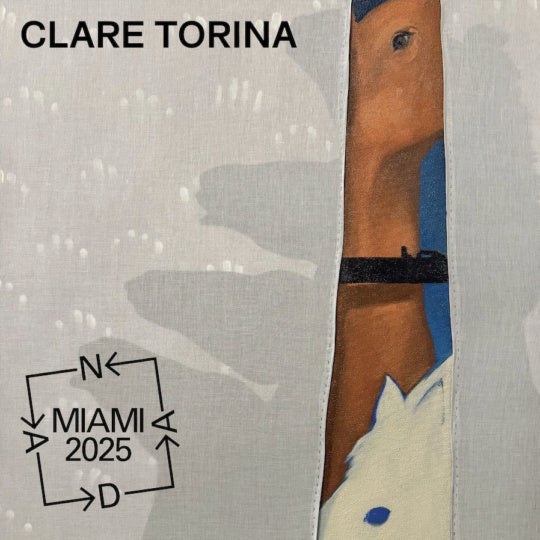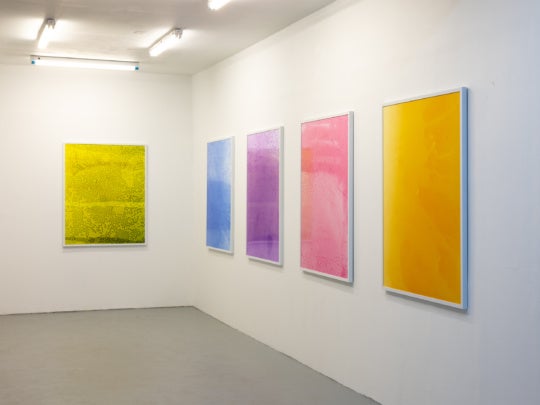
The art world is full of cynics—critics who proclaim the death of traditional mediums, artists who toil away, unappreciated by the market, and advocates who see no end to the gap in public funding, infrastructure, and support. That is why meeting an artist like Maggie Davis is such a breath of fresh air.
Maggie Davis, a 72-year-old artist in her prime, has been undeniably productive post-retirement (including writing for BURNAWAY) and has recently garnered a following in Atlanta. Though private and public collections across Georgia and Florida (her native state) have been acquiring her work for decades, her solo show at Sandler Hudson, which opened on December 17, is her first commercial gallery show here in Atlanta. Most who know her would agree that she exudes a kind of authenticity and truly believes in the expressive value of art. It is easy to tell she enjoys being in the studio, that she spends time learning her medium and doesn’t rush her process.
The crowd at the opening of “The Fourth Wall” at Sandler Hudson mirrored the energy of Davis’s large-scale paintings, which comprise dark hues mixed with pastels, delicate colors, and fractured compositions that play with texture and space.

Her compositions are vertically oriented by color that Davis guides downward with large paint brushes and palette knives. In some works, the canvas soaks up the color as if quenching a thirst. Colors run into one another in the way Helen Frankenthaler’s do. The paint drips and bleeds in layers. In a video of her working in her studio at the Goat Farm Arts Center, she even uses her fingers to massage the paint into the canvas. In this same video, she talks about her line work, “The mark that the hand makes is an affirmation of life.” She places great emphasis on the first marks on her canvas; it is for her an initiation of conversation.
You could cut Davis’s large canvases into smaller panels and they would still feel complete. There are many “scenes” (if you will) within the one large “landscape” of color play. Like Kandinsky’s whimsical work inspired by music, colored lines and shapes jump across the planes of Davis’s art. Her works seem to depict music too, but unlike Kandinsky’s, her titles reference literature. The effect of her work is almost a synesthetic experience—the flashing of images before one’s eyes, ignited by another stimulated sense.
The layering of warm and cool colors plays with the eye, pushing forward, and receding backward into the picture plane. Colors in The Nursery are bright and luscious—like those that might liven the pages of an illustrated Alice in Wonderland. Texture in some of the paintings, like The Orchard, The Departure, and her Non Sequitur series, resemble that of a birch tree, revealing layers of different color and texture underneath, the way the flaky bark of a birch tree peels back and molts. The Arrival has the visual quality of a cracked fresco painting well beyond its years. In the back gallery, smaller works are hung in a grid. They give insight into Davis’s process, and highlight the “mark” she emphasizes.

In an interview with BURNAWAY, when asked about the possibility of narrative in her work, Davis replied, “I am connected to the idea of the marks and the space in between as a kind of narrative.” It is an unconventional narrative—non-linear and indistinct. Davis spoke about the “narrative potential of abstraction” but stressed that the relationship of elements within a work is more significant. She speaks of her work like it is a conversation, a fluid process in which she is trying to coax the work into being with paint.
Davis reminds us that art doesn’t have to proselytize, shock, or make you uncomfortable in order to convey a message. It can be open to interpretation, left to the viewer’s imagination. We have a tendency to over conceptualize art. We want it to pose a question, and then answer it. These paintings don’t, they aren’t literal or explicit. They are open-ended, but still intriguing.
Davis’s work doesn’t shock or trick you. It exudes a certain grace. It restores order. The works are abstract and accessible. ]The title of her show is “The Fourth Wall”—a term in theater that refers to the invisible wall between the actors on stage and the audience before them—but perhaps the show could be renamed Removing The Fourth Wall—because it does just that.

“The Fourth Wall” by Maggie Davis is up through January 28 at Sandler Hudson Gallery.
Jac Kuntz is an arts writer, editor, journalist, and artist living in Atlanta. She is a recent graduate of the Masters of Arts Journalism program at the School of the Art Institute of Chicago. She also holds a BA in Psychology and a BFA in Painting with a concentration in art history from Clemson University.




